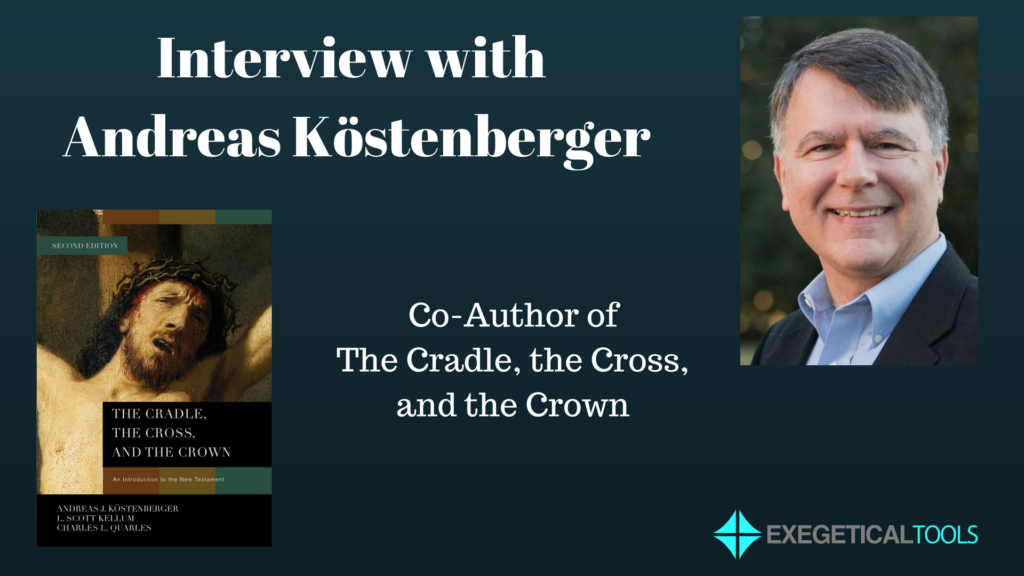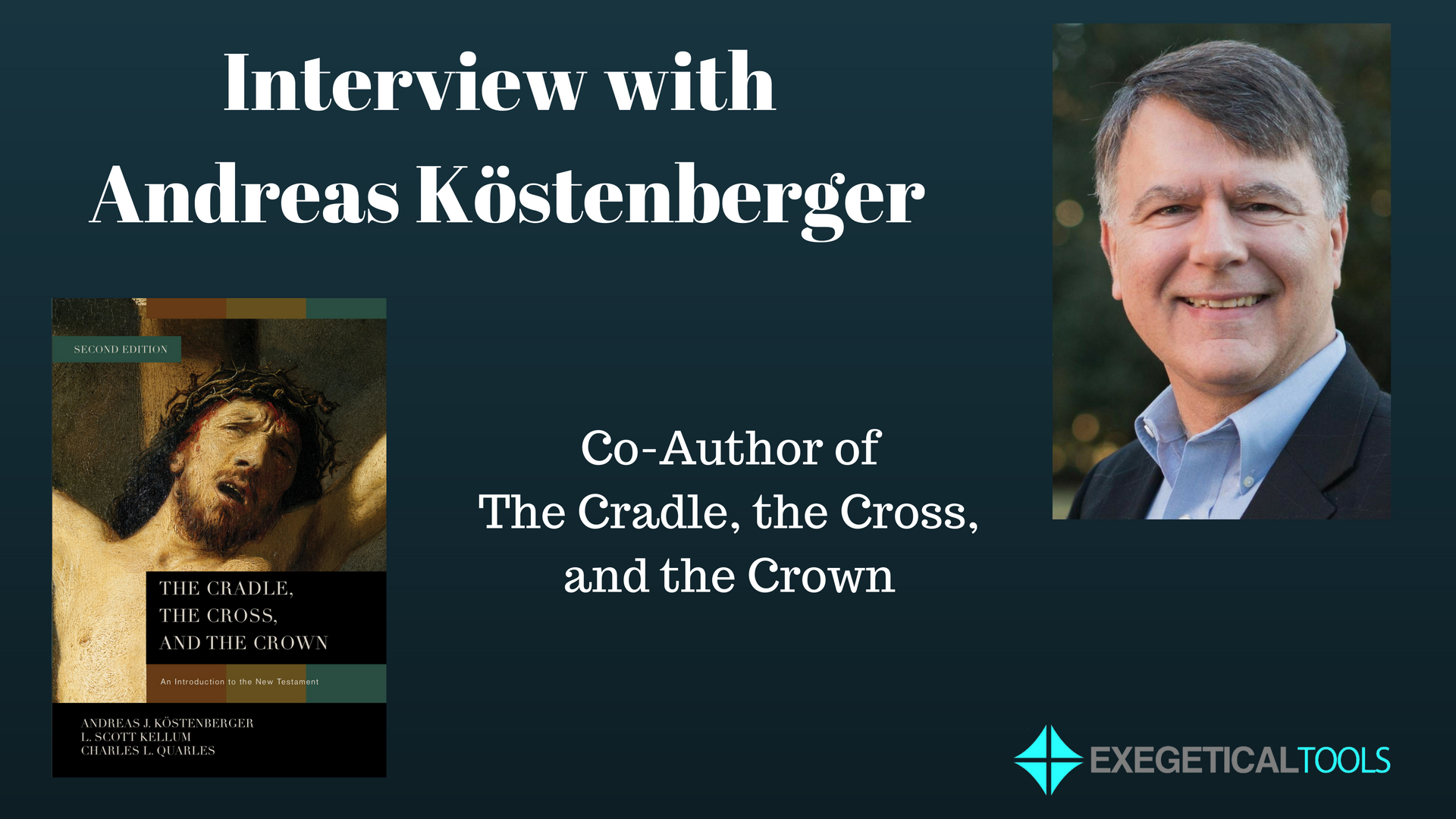
New Testament introduction is an area that every seminary student must wade through because it is foundational to how we understand our Scriptures. Textbooks must therefore address the most critical issues, but Evangelical textbooks have an additional task of promoting the spiritual growth of students. The Cradle, the Cross, and the Crown (2nd ed.) is a textbook that strikes an elegant balance, about which you can read more here. Andreas Köstenberger, co-author along with Scott Kellum and Chuck Quarles, was kind enough to answer some questions about his textbook and about issues involved in this important subject matter.
Exegetical Tools
The Cradle, the Cross, and the Crown (2nd ed.) is the most recently published New Testament introduction. Why will it be as useful as, or more useful than its Evangelical predecessors such as Carson/Moo’s or D. Guthrie’s?
Andreas Köstenberger
Good question! I was asking myself the same question when I first contemplated writing a NT introduction several years ago. After all, Don Carson was my mentor at Trinity, and Doug Moo was one of my professors there, and I have utmost respect for both of these men (as well as Leon Morris, on whom I read a paper at last year’s ETS).
A few thoughts on CCC2’s usefulness, though:
- We include a chapter on the Second Temple period, both its history and literature (chap. 2); I believe this is vital for teachers and students of the NT in that it provides much-needed background on NT figures such as the Pharisees or the Sadducees and on the religious and political situation in first-century Palestine.
- We try to be spiritually nurturing rather than being boring, dry, and purely academic (I’m not implying that the other NTIs you mentioned are, of course). For example, we include at least one devotional on each NT book and try to start each chapter with an interesting fact or anecdote to stir interest.
- We include robust unit-by-unit discussions of the various NT books to help people actually get into the text and the narrative or discourse of Scripture. That way people are not just reading about the NT, they’re hopefully getting into the NT.
- At the end of every chapter, we have fairly meaty discussions of important theological themes. In this way, we provide a cumulative mini-biblical theology of the NT, not to mention succinct lists of the distinctive contribution of a given book to the NT canon to conclude each chapter.
- Finally, interaction with scholarship and bibliographies are now again up to date. This is vital, as scholarship continues to pour down the presses in areas such as the new perspective on Paul, Synoptic studies, Johannine research, and so on.
ET
What do you feel are some of the most pressing issues in NT scholarship that you addressed in this textbook, and how do you hope students and pastors will be helped by the discussions?
Köstenberger

Andreas J. Köstenberger is Senior Research Professor of New Testament and Biblical Theology at Southeastern Baptist Theological Seminary.
In chapter 1, we address important issues surrounding the NT canon and biblical authority. In this way, our NT introduction is properly grounded doctrinally, which sets it apart from its historical-critical counterparts. Having taught NT introduction for many years, we want to equip teachers and students by giving them a tool that is based on a high regard for the NT as inspired Scripture.
For the 2nd edition, we added new sections on how to interpret the different genres of Scripture (such as Gospels, epistles, etc.), as well as an epilogue tracing the storyline of Scripture in biblical-theological fashion. For this reason we strongly recommend that even those who are familiar with the 1st edition avail themselves of the 2nd edition.
Another important issue we’re dealing with in the chapter on the letters to Timothy and Titus is the alleged pseudonymity of these letters, which continues to be hotly debated. I’ve written a forthcoming commentary on these books (BTCP series, due out in May 2017) and have provided a sneak preview with regard to introductory matters in this chapter.
ET
This textbook is massive, at around 1,100 pages. How would this large textbook benefit a busy pastor who preaches often on NT texts, sometimes even preaching straight through a NT book?
Köstenberger
Personally, I believe The Cradle, the Cross, and the Crown is an indispensable resource that deserves to be on the shelf (or screen) of every pastor and serious student of the Bible. If you’re preaching or teaching on a given book of the NT, I would highly recommend you start by reading through the chapter on that book in our NT introduction as a way of being grounded in the history, literature, and theology of that NT book. Then, you can flesh out your own insights passage by passage within that larger historical, literary, and theological framework canvassed in our volume.
ET
You stress not only theology, but also history and literature—what you call the “hermeneutical triad.” Why are the historical details important? Why can’t we just read the New Testament and extract its theology?
Köstenberger
Very true. As you observe, we self-consciously based our entire volume on the hermeneutical triad of history, literature, and theology, set forth in my books Invitation to Biblical Interpretation and For the Love of God’s Word. The way this works is that we first discuss standard introductory matters such as authorship, date, audience, occasion, purpose, etc., before turning to the book’s genre, structure, and other literary features. After this, we provide discussions of several of the major theological themes featured in a given NT book (a unique feature of our NT introduction, as mentioned).
In recent years, we’ve seen a “literary turn” in academic circles, including biblical studies. Often, this means that history is neglected, in part because scholars are skeptical with regard to the Bible’s historical accuracy. But Christianity is a historical religion and stands and falls with the historicity of the events surrounding Jesus’ crucifixion and resurrection. If we neglect history, a precarious vacuum opens up that more often than not will be filled with an interpreter’s own contemporary cultural lenses, and as a result, validity in interpretation will be lost, and proper application be compromised. I think this is important even when it comes to biblical theology, which is very popular today, but which is often conducted primarily on the level of literary themes rather than understood within its proper historical context.
Christianity stands and falls with the historicity of Jesus’ crucifixion and resurrection Share on XWhile I don’t concur with all of N. T. Wright’s proposals, I do find that he is an excellent example of someone who tries to do justice to the historical, first-century Jewish and Greco-Roman context of early Christianity.
ET
Thank you very much, Andreas, for this important new edition of your NT introduction. We’re grateful to you and your co-authors, your colleagues Scott Kellum and Chuck Quarles, for providing a very thorough treatment, and one that is characterized by a consistently high view of Scripture. We hope that many will benefit from this resource as they study God’s Word and teach it to others.
Learn more about The Cradle, the Cross, and the Crown at our post here, or preview and buy it directly from Amazon.


